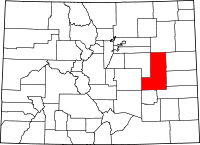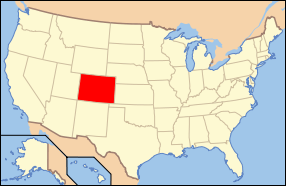Lincoln County, Colorado
| Lincoln County, Colorado | |
|---|---|
|
Lincoln County Courthouse in Hugo | |
 Location in the U.S. state of Colorado | |
 Colorado's location in the U.S. | |
| Founded | April 11, 1889 |
| Named for | Abraham Lincoln |
| Seat | Hugo |
| Largest town | Limon |
| Area | |
| • Total | 2,586 sq mi (6,698 km2) |
| • Land | 2,578 sq mi (6,677 km2) |
| • Water | 8.8 sq mi (23 km2), 0.3% |
| Population (est.) | |
| • (2015) | 5,557 |
| • Density | 2.1/sq mi (1/km²) |
| Congressional district | 4th |
| Time zone | Mountain: UTC-7/-6 |
| Website |
www |
Lincoln County is one of the 64 counties in the U.S. state of Colorado. As of the 2010 census, the population was 5,467.[1] The county seat is Hugo.[2] The county obtains its name in memory of President Abraham Lincoln.[3]
Geography
According to the U.S. Census Bureau, the county has a total area of 2,586 square miles (6,700 km2), of which 2,578 square miles (6,680 km2) is land and 8.8 square miles (23 km2) (0.3%) is water.[4]
The main watersheds include the Arikaree and Republican Rivers in the northern part of the county and the Big Sandy, Rush, and Horse Creeks in the southern part of the county. Big Sandy and Rush Creeks ultimately drain into the Arkansas River.[5]
Adjacent counties
- Washington County - north
- Kit Carson County - east
- Cheyenne County - east
- Crowley County - south
- Kiowa County - south
- Elbert County - west
- El Paso County - west
- Arapahoe County - northwest
- Pueblo County - southwest
Government
Lincoln County's government is based in the county courthouse in Hugo which is the office of the board of three elected commissioners and a county administrator, as well as the county sheriff, county clerk and recorder, county assessor, county treasurer, county coroner, and the county court (the trial court of limited jurisdiction for county affairs). Lincoln County is part of the 18th Colorado Judicial District — the state trial court of general jurisdiction — with judicial matters conducted in the Littleton and Centennial courthouses in Arapahoe County. Lincoln County's government operation also includes a department of social services, land use office, road and bridge department, human services department, public health department, mobile library services, probation department, county landfill, county fairgrounds, and county extension service.
Demographics
| Historical population | |||
|---|---|---|---|
| Census | Pop. | %± | |
| 1890 | 689 | — | |
| 1900 | 926 | 34.4% | |
| 1910 | 5,917 | 539.0% | |
| 1920 | 8,273 | 39.8% | |
| 1930 | 7,850 | −5.1% | |
| 1940 | 5,882 | −25.1% | |
| 1950 | 5,909 | 0.5% | |
| 1960 | 5,310 | −10.1% | |
| 1970 | 4,836 | −8.9% | |
| 1980 | 4,663 | −3.6% | |
| 1990 | 4,529 | −2.9% | |
| 2000 | 6,087 | 34.4% | |
| 2010 | 5,467 | −10.2% | |
| Est. 2015 | 5,557 | [6] | 1.6% |
| U.S. Decennial Census[7] 1790-1960[8] 1900-1990[9] 1990-2000[10] 2010-2015[1] | |||
As of the census[11] of 2000, there were 6,087 people, 2,058 households, and 1,389 families residing in the county. The population density was 2 people per square mile (1/km²). There were 2,406 housing units at an average density of 1 per square mile (0/km²). The racial makeup of the county was 86.30% White, 4.96% Black or African American, 0.94% Native American, 0.56% Asian, 0.03% Pacific Islander, 5.65% from other races, and 1.56% from two or more races. 8.53% of the population were Hispanic or Latino of any race.
There were 2,058 households out of which 33.70% had children under the age of 18 living with them, 55.30% were married couples living together, 8.40% had a female householder with no husband present, and 32.50% were non-families. 29.00% of all households were made up of individuals and 13.00% had someone living alone who was 65 years of age or older. The average household size was 2.44 and the average family size was 3.04.
In the county the population was spread out with 23.90% under the age of 18, 7.10% from 18 to 24, 33.00% from 25 to 44, 21.80% from 45 to 64, and 14.30% who were 65 years of age or older. The median age was 38 years. For every 100 females there were 130.90 males. For every 100 females age 18 and over, there were 140.70 males.
The median income for a household in the county was $31,914, and the median income for a family was $39,738. Males had a median income of $25,742 versus $22,188 for females. The per capita income for the county was $15,510. About 8.10% of families and 11.70% of the population were below the poverty line, including 14.40% of those under age 18 and 11.50% of those age 65 or over.
Communities
Historic trail
The name "Smoky Hill" comes from the appearance of the misty or smoky hills that the westward travelers viewed on their journey from Kansas and Nebraska Territories and Missouri toward the Colorado Gold Rush starting in 1858. Gold, had been discovered in the Cherry Creek, near Denver. The image of the misty hills and valleys along the route west gave the name to the trail for these travelers — the Smoky Hill Trail. Parts of the trail can still be seen as a two-track road on the Eastern Plains in what was once Kansas Territory but now is Colorado.
The section of the Smoky Hill Trail which passes through much of the High Plains has become known as the "starvation trail." This section of the trail proved to be the most difficult, due to a lack of water, yet the Plains Indians of the day considered this region as prime hunting ground.[12]
See also
- Outline of Colorado
- Index of Colorado-related articles
- National Register of Historic Places listings in Lincoln County, Colorado
References
- 1 2 "State & County QuickFacts". United States Census Bureau. Retrieved February 11, 2014.
- ↑ "Find a County". National Association of Counties. Retrieved 2011-06-07.
- ↑ Gannett, Henry (1905). The Origin of Certain Place Names in the United States. U.S. Government Printing Office. p. 187.
- ↑ "US Gazetteer files: 2010, 2000, and 1990". United States Census Bureau. 2011-02-12. Retrieved 2011-04-23.
- ↑ Terry Blevins, "Lincoln County, Colorado: America's Home on the Range." http://lincolncountycoloradotourism.com/
- ↑ "County Totals Dataset: Population, Population Change and Estimated Components of Population Change: April 1, 2010 to July 1, 2015". Retrieved July 2, 2016.
- ↑ "U.S. Decennial Census". United States Census Bureau. Retrieved June 8, 2014.
- ↑ "Historical Census Browser". University of Virginia Library. Retrieved June 8, 2014.
- ↑ "Population of Counties by Decennial Census: 1900 to 1990". United States Census Bureau. Retrieved June 8, 2014.
- ↑ "Census 2000 PHC-T-4. Ranking Tables for Counties: 1990 and 2000" (PDF). United States Census Bureau. Retrieved June 8, 2014.
- ↑ "American FactFinder". United States Census Bureau. Retrieved 2011-05-14.
- ↑ "History of Smoky Hill Trail." SmokyHillBound.com http://www.smokyhillbound.com/history-smoky-hill-trail-area
External links
- Lincoln County Government website
- Colorado County Evolution by Don Stanwyck
- Colorado Historical Society
 |
Arapahoe County | Washington County |  | |
| Elbert County and El Paso County | |
Kit Carson County and Cheyenne County | ||
| ||||
| | ||||
| Pueblo County | Crowley County and Kiowa County |
Coordinates: 38°59′N 103°31′W / 38.98°N 103.52°W
